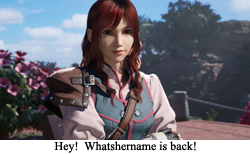Today’s article is a look at the final dungeon of Final Fantasy 7 Rebirth. If you would like that area and its surrounding plot to be a surprise, by all means, please do not read this in-depth screed. Spoiler warning and all that riot.
 Game designers, I am begging you to know when to stop having videogame in your videogame.
Game designers, I am begging you to know when to stop having videogame in your videogame.
There is a phrase out there that sends a tingle down the spine of a certain class of people: “filler episode”. This concept originated predominantly with anime viewers, but has bled into other mediums as well. The thinking is simple: since approximately the late 90’s, much of entertainment has forsaken the idea of “standalone” episodes that are meant to be watched in any order, and started nursing at the teat of endless continuity. Not unlike the soap operas of ages past, hundreds of hours of stories are now one continuous tale, and if you so much as miss a single episode, you will never understand the tragic reason our main protagonist now has an arm-flipper. It is not hard to ascertain how this kind of storytelling has become popular (executives love how a show basically advertises itself, writers love not having to come up with a completely independent plot every week, streaming services love watching their audience evolve into human-couch hybrids), but one significant downside is that it has transformed the steadfastly stable fans into rabid monsters. Since there is an overall arc, the people demand that every episode and story be in service of that arc, and if our protagonists so much as spend a single episode chasing a fly around the basement, it is deemed “filler”, and written-off wholesale. Nobody cares if such an episode might be an insightful vision into beloved characters; if the hero or villain doesn’t do something this week, it is pointless.
And I have been thinking about this phenomenon a lot recently, as I have been gradually rewatching Bleach.
For those of you that did not immediately groan when Bleach was mentioned, here is a quick primer on that franchise. The elevator pitch is that an average high school boy meets a local grim reaper, and then said high school boy gets “substitute” grim reaper powers to deal with the fact that the afterlife is crowded with skeleton monsters that are weak to swords. The first season or so of Bleach is a slice of life story with Ichigo Kurosaki hanging with his friends and surviving his homicidal parttime job, but everything ramps up when it is revealed that the afterlife has its own entrenched bureaucracy of dudes that solve every problem with a level of violence usually reserved for John Wick. After fighting everyone in this metaphorical (and vaguely literal) Heaven, one of the leaders defects to Hell, and the remainder of the franchise is fighting everyone on the other side of the afterlife coin. Complete with how 90% of 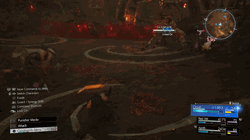 these battles are presented like a fighting tournament (“Here is Next Opponent, and his special power is Does A Thing, how will Main Character ever overcome this latest challenge!?”) without the official tournament trappings (they are fighting for the fate of the world, so no big stakes or anything), the whole series is pretty typical shonen anime fare. Introduction, fight fake bad guys who become friends, fight real bad guys, and call it a day.
these battles are presented like a fighting tournament (“Here is Next Opponent, and his special power is Does A Thing, how will Main Character ever overcome this latest challenge!?”) without the official tournament trappings (they are fighting for the fate of the world, so no big stakes or anything), the whole series is pretty typical shonen anime fare. Introduction, fight fake bad guys who become friends, fight real bad guys, and call it a day.
Except… here are the rough episode counts for how this all goes down.
- The Substitute Shinigami (Introduction): Episodes 1-15
- The Soul Society Arc (Bad Guys to Good Guys Time): Episodes 16-63
- Find and Defeat Aizen Arc (Beat the Bad Guy): Episodes 64-310
Fifteen episodes of introduction, almost fifty for the midpoint, and then five times that for “let’s actually finish what we started”.
Now, any big Bleach fans in the audience are already unsheathing their zanpakutōs and noting that this episode count is misleading. Bleach was airing opposite the production of the Bleach manga, so there were multiple occasions where this weekly television show got ahead of the source material. When that happened, initially the anime would simply toss a “one-off” adventure of side characters. As the series went on, entire “filler arcs” were produced, and Ichigo and friends would be effectively transported to an alternate dimension where they could play around and not influence the “real” plot. There are many, many episodes of that 246 count above where Aizen is not even mentioned, and the “main plot” effectively does not exist. Your favorite heroes are not worrying about that other problem right now, so you shouldn’t either. Just have fun with Bleach an’ the gang!
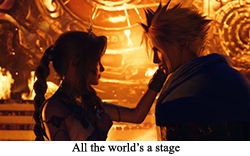 Except… We, the audience of Bleach, are deteriorating meat sacks with a limited time on this planet. Everything we do, say, and watch is partially influenced by our own mortality. The worst insult you can lob at a piece of media is not a subjective “it’s bad,” it is “this is a waste of time”. And when you know your protagonist has a clear goal, and they are not doing anything to achieve that goal, then you are actively participating in a waste of time. It is not a matter of whether you cannot enjoy this time you are spending with beloved characters and familiar situations, it is that you are literally wired from birth to achieve goals and make progress. When you see someone not making progress, even if it is entertaining not-progress, there is a genetic part of you that identifies this lack of progress as bad. When Ichigo has ten conveniently-numbered guys that he must defeat before fighting the main guy, you know you are not going to see a finale before those ten guys get to introduce their special powers and tragic backstories. And when Ichigo isn’t even in the same dimension as those ten guys, you know progress is not going to happen for a while. It is not just filler, it is a pointless waste of time. It is the worst.
Except… We, the audience of Bleach, are deteriorating meat sacks with a limited time on this planet. Everything we do, say, and watch is partially influenced by our own mortality. The worst insult you can lob at a piece of media is not a subjective “it’s bad,” it is “this is a waste of time”. And when you know your protagonist has a clear goal, and they are not doing anything to achieve that goal, then you are actively participating in a waste of time. It is not a matter of whether you cannot enjoy this time you are spending with beloved characters and familiar situations, it is that you are literally wired from birth to achieve goals and make progress. When you see someone not making progress, even if it is entertaining not-progress, there is a genetic part of you that identifies this lack of progress as bad. When Ichigo has ten conveniently-numbered guys that he must defeat before fighting the main guy, you know you are not going to see a finale before those ten guys get to introduce their special powers and tragic backstories. And when Ichigo isn’t even in the same dimension as those ten guys, you know progress is not going to happen for a while. It is not just filler, it is a pointless waste of time. It is the worst.
And Final Fantasy 7 Rebirth has a problem with filler in its finale.
It is subtle, but somewhere in Final Fantasy 7 Rebirth it becomes clear that we are dealing with the platonic ideal of Crisis Core: Final Fantasy VII. That was a game that will forever be a PSP exclusive despite being rereleased/upgraded for modern consoles. It was optimized for the portable experience, and thus had a gameplay loop wherein the “main plot” was a traditional handful of chapters with dedicated dungeons, plot, and bosses. But it also contained a plethora of side mission content, and these side missions could be individually conquered in the restricted amount of time it takes for you to beat a homicidal ostrich. And that is ideal for a game that wants to simultaneously be “epic” and “portable”. Play the big damn plot when you have some time to yourself, but bang out those missions when you are in line for the latest showing of The Number 23. And it works wonderfully, because, in a game that is a prequel where you ultimately know what is going to happen (Zack has a really bad day or two), you can make progress at your preferred pace. If you want to race to the finish, keep choosing those story missions. If you want to just enjoy the “filler”, mission it up for an hour or seventy. You know Zack’s ending, but you control Zack’s present.
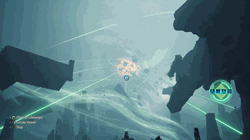 Final Fantasy 7 Rebirth took this concept and seamlessly integrated it into its world. This is a dramatic change from Crisis Core: Final Fantasy VII, where the GUI does immersion no favors. Despite a change of venue or two across the game, Zack is always simply selecting missions off an assignment menu, and these “missions” could only feel more like videogame stages if Pac-Man were involved. In Rebirth, however, you still have an immediately obvious line between “main plot” and “side missions”, but the secondary content is part and parcel with exploring the planet. There are a thousand things to do once you reach Junon, and you have the option to head straight forward to your destination, or explore a region that is (literally) 85% optional. And this happens organically! You might be dead set on advancing the plot, but you see chocobo tracks on the way. Or a Republic Tower. Or a weird looking cat. And when you investigate that phenomenon, you see something else that grabs your attention… And before you know it, MAI is giving you a congratulatory pat on the back for making an entire species of fiend extinct. And you never chose that option off a menu! It just kind of happened, and you enjoyed every minute of it. It is the culmination of the dream of Crisis Core: Final Fantasy VII, which is an amazing bit of Compilation of Final Fantasy 7 synergy.
Final Fantasy 7 Rebirth took this concept and seamlessly integrated it into its world. This is a dramatic change from Crisis Core: Final Fantasy VII, where the GUI does immersion no favors. Despite a change of venue or two across the game, Zack is always simply selecting missions off an assignment menu, and these “missions” could only feel more like videogame stages if Pac-Man were involved. In Rebirth, however, you still have an immediately obvious line between “main plot” and “side missions”, but the secondary content is part and parcel with exploring the planet. There are a thousand things to do once you reach Junon, and you have the option to head straight forward to your destination, or explore a region that is (literally) 85% optional. And this happens organically! You might be dead set on advancing the plot, but you see chocobo tracks on the way. Or a Republic Tower. Or a weird looking cat. And when you investigate that phenomenon, you see something else that grabs your attention… And before you know it, MAI is giving you a congratulatory pat on the back for making an entire species of fiend extinct. And you never chose that option off a menu! It just kind of happened, and you enjoyed every minute of it. It is the culmination of the dream of Crisis Core: Final Fantasy VII, which is an amazing bit of Compilation of Final Fantasy 7 synergy.
However, there is a downside to this situation. When the greatest challenges in the game are associated with optional content, and require a basis in other optional content, well, the whole “optional” thing starts becoming questionable. If you want the best and most amusing summon ability in Final Fantasy 7 Rebirth, you must complete multiple side quests across multiple areas, and then participate in what amounts to a summoning fighting tournament. And that is a lot of fun! But, for all the individual pieces of that sidequest being separately optional, if you want to skip to that grand finale tournament, tough noogies. All that is optional becomes mandatory. And if you do not like one of those side quests (say, because it involves a minigame with rules and win conditions that are all as about as transparent as a cactuar’s behind), too bad, you must catch ‘em all to get Mewtwo. And what does this do to the main quest? After all the effort you put into completing optional content, how could the main content compare? This has to be fair for everyone, and if someone skipped the content that is (by definition) optional, can they be on the same level? Everyone, regardless of available free time, should be able to experience a final test that is equally epic.
For two Final Fantasy 7 games in a row (what a weird thing to be able to say), the answer has been “make the final dungeon long as hell”.
And, ladies and gentlemen, boy does that suck.
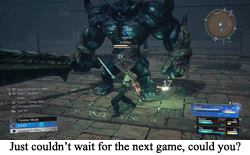 Final Fantasy 7 Remake and Final Fantasy 7 Rebirth both have the same end game. The absolute final chapter is a grandiose final event where secrets are revealed, bosses are fought, and an uncertain conclusion only comes through a fevered battle (also: a weirdly high number of tornadoes). And, in both games, the chapter immediately before that finale is “the final dungeon”, a sprawling labyrinth of inconsequential fights, random minigames, and the occasional park bench. In both games, this dungeon has been retrofitted from “this was generally important in the original” to “this is the most important place” to varying degrees. In Final Fantasy 7 Remake, it is appropriately the Shrina Building, the sprawling headquarters of the company that is trying to destroy you and everyone else. In Final Fantasy 7 Rebirth, it is The Temple of the Ancients, the oldest structure on the planet that incidentally houses a magic crystal that can destroy the world. In both cases, we have something appropriately epic and relevant to the plot, and you can even wring some pathos out of these dungeons offering a fine excuse for characters to confront their pasts and futures. Seems like a great choice for adding finality to the fantasy.
Final Fantasy 7 Remake and Final Fantasy 7 Rebirth both have the same end game. The absolute final chapter is a grandiose final event where secrets are revealed, bosses are fought, and an uncertain conclusion only comes through a fevered battle (also: a weirdly high number of tornadoes). And, in both games, the chapter immediately before that finale is “the final dungeon”, a sprawling labyrinth of inconsequential fights, random minigames, and the occasional park bench. In both games, this dungeon has been retrofitted from “this was generally important in the original” to “this is the most important place” to varying degrees. In Final Fantasy 7 Remake, it is appropriately the Shrina Building, the sprawling headquarters of the company that is trying to destroy you and everyone else. In Final Fantasy 7 Rebirth, it is The Temple of the Ancients, the oldest structure on the planet that incidentally houses a magic crystal that can destroy the world. In both cases, we have something appropriately epic and relevant to the plot, and you can even wring some pathos out of these dungeons offering a fine excuse for characters to confront their pasts and futures. Seems like a great choice for adding finality to the fantasy.
But there is a difference between “relevance” and “progression”. As anyone that played Final Fantasy 7 may remember, there are four significant beats in the Temple of the Ancients:
- Shina attempts to raid the place, which leads to the ambiguously fatal injury of Tseng.
- There is a dragon miniboss
- There is a wall trap boss
- At the finale, Cait Sith sacrifices himself (kinda) to obtain the Black Materia
And those are some great plot beats! Death! Sacrifice! Slaying a dragon! Fighting an infamous Final Fantasy 4 legacy creature! These are the elements of great myths throughout history! And the only drawback to the whole situation is that it takes freaking hours to do these four things. What takes up all the other time? Random encounters with meaningless critters, a weird field action that feels like a PS2 test of the analogue rotation function, an army of fodder Shinra soldiers getting tossed into the woodchipper, and a handful of scenes that confirm Cloud is not having a great mental health day. In the end, the exact same Final Fantasy 7 plot beats happen, just spaced out over a dramatically longer period.
And, Lifestream help me, after Final Fantasy 7 Rebirth expanded 33% of a 40-hour game to one whole 70-hour game and astonishingly made it good… This sucks. The “epic final dungeon” feels like… a filler episode.
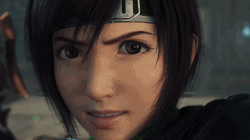 It is easy to understand how this happened. The “filler” that transformed areas like Corel Prison into a fully formed society of living, breathing people experiencing tragedy (and chocobo racing) was carefully calculated not only to tug at your heart strings, but engage the player with new and interesting things to do and learn. Regions that were previously little more than pitstops (or entirely missable, hi Gongaga!) are now engaging because there is something there to engage with. The final dungeon does not have that. It has interesting battles, but nothing about them are unique to this area. This could all be Chadley’s simulator, and nothing would have to be different. You have Shinra sucking and Cloud PTSD’ing, but both of those aspects were already omnipresent in the narrative. And Aerith’s mysterious new powers are nebulously cool (at least they impact the random battles a little bit), but they are also clearly keys for the specific locks within this dungeon. Even if this weren’t the end of the game (and maybe Aerith), there is no expectation here that Aerith just earned a world changing Screw Attack. This is the Spring Ball at best. And with all of that off the table… Well, all you have left are those mandatory plot beats from the first game that must be fulfilled. And you damn well know that Tseng isn’t going to (kinda) die and the boss isn’t going to appear when your party is separated. Yes, in order to see everyone get a turn, your team is split into two groups after the dragon fight, and you have to fight your way back to a fully functional AVALANCHE. And this little detour emphasizes that familiar filler feeling. We have a goddamned “let’s have a cute adventure with the side characters” event and a tutorial for a new skill in the middle of the final dungeon.
It is easy to understand how this happened. The “filler” that transformed areas like Corel Prison into a fully formed society of living, breathing people experiencing tragedy (and chocobo racing) was carefully calculated not only to tug at your heart strings, but engage the player with new and interesting things to do and learn. Regions that were previously little more than pitstops (or entirely missable, hi Gongaga!) are now engaging because there is something there to engage with. The final dungeon does not have that. It has interesting battles, but nothing about them are unique to this area. This could all be Chadley’s simulator, and nothing would have to be different. You have Shinra sucking and Cloud PTSD’ing, but both of those aspects were already omnipresent in the narrative. And Aerith’s mysterious new powers are nebulously cool (at least they impact the random battles a little bit), but they are also clearly keys for the specific locks within this dungeon. Even if this weren’t the end of the game (and maybe Aerith), there is no expectation here that Aerith just earned a world changing Screw Attack. This is the Spring Ball at best. And with all of that off the table… Well, all you have left are those mandatory plot beats from the first game that must be fulfilled. And you damn well know that Tseng isn’t going to (kinda) die and the boss isn’t going to appear when your party is separated. Yes, in order to see everyone get a turn, your team is split into two groups after the dragon fight, and you have to fight your way back to a fully functional AVALANCHE. And this little detour emphasizes that familiar filler feeling. We have a goddamned “let’s have a cute adventure with the side characters” event and a tutorial for a new skill in the middle of the final dungeon.
And then when I steered my heroes into a room with six different doors so six different party members could experience nebulous flashbacks? I damn near threw my controller at the screen…
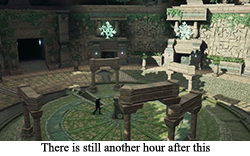 There is supposed to be something here. This is the last you will see these characters for another four years, and the “real” ending is laser-focused on Cloud and Aerith (and that guy with the silver hair). The impulse to let everybody have a turn at the quasi-finale is noble, and speaks to how the designers of the Final Fantasy 7 Remake Compilation (I’m calling it that, you can’t stop me) genuinely care for these people (and dog) (and toysaurus). They even sneak in a bit of business for Vincent! You could even claim the length of the dungeon does work for putting the player and Cloud in the same exhausted headspace that would account for some choices our spikey-haired protagonist makes during the dénouement. But looking at all of this from a game perspective? From a Final Fantasy 7 Rebirth that is supposed to be fun, and was fun for approximately 99% of the previous experience (deducting 1% for Cait Sith box throwing)? It is awful. It is filler in every negative way that word has ever been used to describe content.
There is supposed to be something here. This is the last you will see these characters for another four years, and the “real” ending is laser-focused on Cloud and Aerith (and that guy with the silver hair). The impulse to let everybody have a turn at the quasi-finale is noble, and speaks to how the designers of the Final Fantasy 7 Remake Compilation (I’m calling it that, you can’t stop me) genuinely care for these people (and dog) (and toysaurus). They even sneak in a bit of business for Vincent! You could even claim the length of the dungeon does work for putting the player and Cloud in the same exhausted headspace that would account for some choices our spikey-haired protagonist makes during the dénouement. But looking at all of this from a game perspective? From a Final Fantasy 7 Rebirth that is supposed to be fun, and was fun for approximately 99% of the previous experience (deducting 1% for Cait Sith box throwing)? It is awful. It is filler in every negative way that word has ever been used to describe content.
Final Fantasy 7 Remake curators? I am begging you. Please do not repeat this mistake with the finale of Final Fantasy 7 Reunion ³ . Don’t make me fear finishing a game I love.
SBC #32.2 Cloud Strife & Final Fantasy VII Rebirth
Cloud Strife in Super Smash Bros Ultimate
- One more article to go, and then I can play Smash Bros again.
Cloud Strife in Final Fantasy VII Rebirth
- System: Only the Playstation 5 could contain the raw graphical power required for 15 continuous hours of Queen’s Blood.
- Number of players: One. It is Reeve controlling Cait Sith.
- A Different kind of Retro: Thinking of other dungeons, Shinra Mansion was always a “dungeon” in Final Fantasy 7, but now “the mansion is a puzzle” has been transformed into “Hojo has a giant lab underground, and Cait Sith has to throw boxes there”. And that weirdly feels like Final Fantasy 7 Remake: expanding areas from the original game into larger “challenge areas” that do not particularly add anything to the overall plot (we do not need reinforcement that Hojo is a dick). This trope was mostly avoided in Final Fantasy 7 Rebirth (see the previous article for how it expanded the smart way), but, considering it has now been years since Remake, is this intended to be nostalgia for that game? Hey, kids, remember when Barret got stuck leading the party through a secret Hojo lab for some reason?
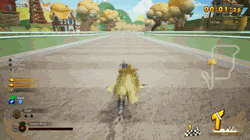 Favorite Party Leader: Final Fantasy 7 Rebirth takes great pains to make sure there is one dungeon per character where somebody other than Cloud gets to take center stage. Sometimes it makes sense (Aerith should be taking point on her ancestors’ home turf), sometimes it feels like an excuse (“Yuffie, you just joined us, and we only vaguely trust you, but you look like you would be great at mountain climbing, so you take Mount Corel.”), and sometimes it all comes together perfectly. Red XIII qualifies as “perfect”, as his dungeon at Cosmo Canyon was always his character spotlight, and being able to run up walls is appropriate for the quadrupedal hound. My only complaint is that Red XIII didn’t get to use that ability in later dungeons. Or earlier ones! I would be okay with a New Game + mode with Red-specific spots.
Favorite Party Leader: Final Fantasy 7 Rebirth takes great pains to make sure there is one dungeon per character where somebody other than Cloud gets to take center stage. Sometimes it makes sense (Aerith should be taking point on her ancestors’ home turf), sometimes it feels like an excuse (“Yuffie, you just joined us, and we only vaguely trust you, but you look like you would be great at mountain climbing, so you take Mount Corel.”), and sometimes it all comes together perfectly. Red XIII qualifies as “perfect”, as his dungeon at Cosmo Canyon was always his character spotlight, and being able to run up walls is appropriate for the quadrupedal hound. My only complaint is that Red XIII didn’t get to use that ability in later dungeons. Or earlier ones! I would be okay with a New Game + mode with Red-specific spots.- Playing Card: Queen’s Blood is ten thousand times more transparent than I expected. You do not need to blow cash on “booster packs”, as all the cards are distinct purchases/wins. You do not have to worry about losing your most valuable cards and fighting to win them back, because the “universe” is tipped in your favor for immediate rematches. And you even are allowed mulligans all over the place. It is maybe the easiest to digest card game I have ever seen in a videogame, and my only concern now is that Square Enix is ramping up to release a mobile version that includes all the problems we dodged in its base game…
- Other things to do: Goddess at the Center of the Planet, there are too many minigames in this thing! If I had to pick a favorite, I would go with the “rhythm play” on your return to the Gold Saucer. I appreciate that it dropped the “floating light” GUI from the Honeybee Inn and Shinra Parade. Just give me buttons to press! Not some weird faery orb that makes it impossible to gauge distance! Second runner-up for a “minigame” is whatever we consider the grappling hook, and anytime we have to hang around like an idiot to reach later areas. Swing is the thing.
- Big Boss: I know one thing about Shrina management…
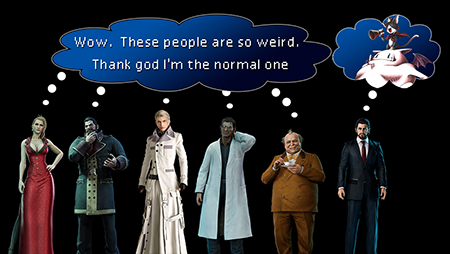
We need to keep using the phrase “nepo baby”.
- Did you know? Final Fantasy 7 originally had yellow, blue, green, black, and gold chocobos. Final Fantasy 7 Rebirth allows you to catch yellow, blue, green, grey, orange, and aqua chocobos. And, somehow, green chocobos in Rebirth traded their mountain powers to gray chocobos between games. Considering how Final Fantasy 7 Remake Compilation slavishly follows the beats of the original, I would like an explanation for why we fussy fans are being given the bird.
- Would I play again: Straight through to the end…
What’s next? Come back Friday for a focused look at the finale of Final Fantasy 7 Rebirth. I bet there will be more spoilers! Please look forward to it!
